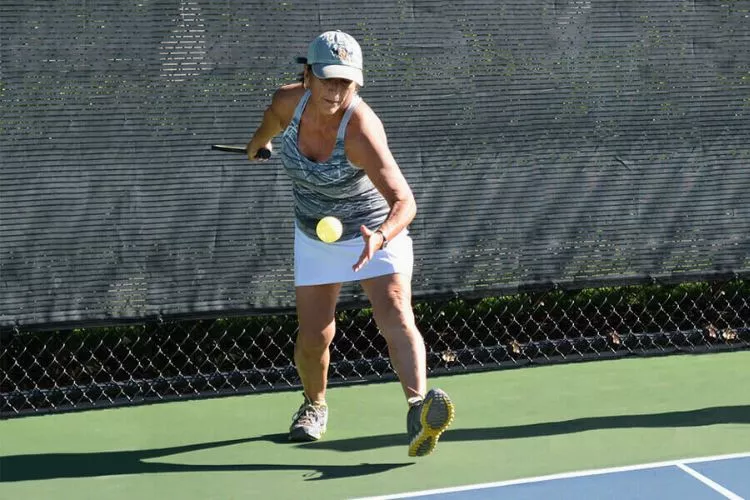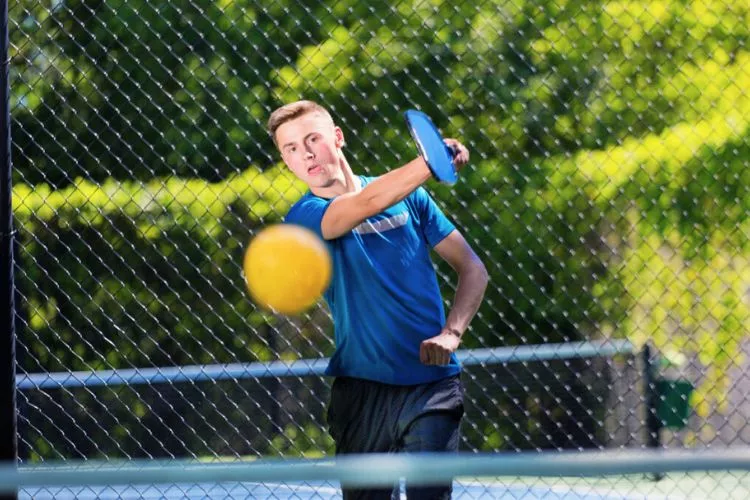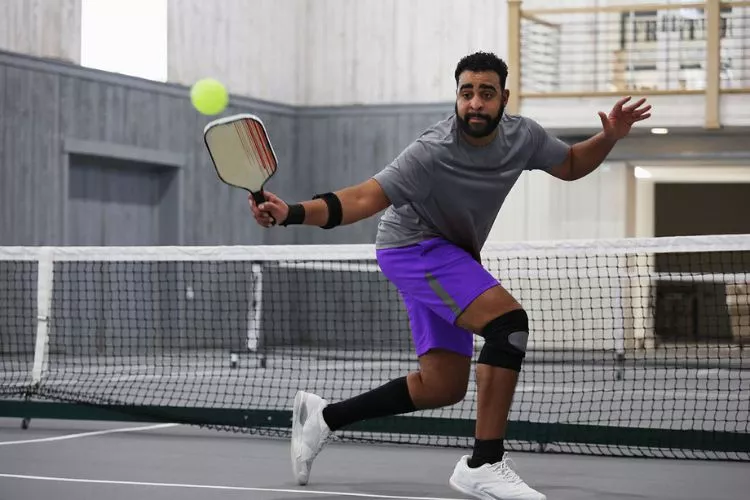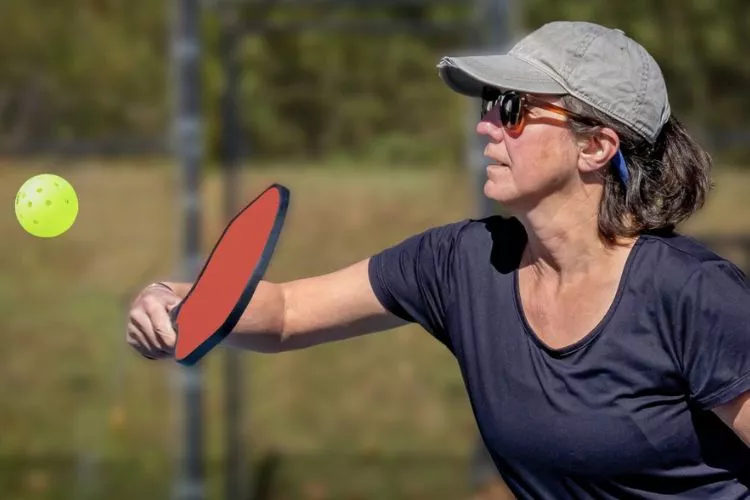Pickleball may look simple, but a strong and strategic serve can greatly influence the outcome of any match.
This article will lay out fundamental pickleball serving tips for beginners or intermediate players aiming to up their game.

From proper positioning to mastering power and precision, let’s delve into these must-know techniques that can take your pickleball serving to the next level.
Whether you’re new to this fast-growing game or looking to refine your skills, these practical tips are here to aid your pickleball journey.
Basic Pickleball Serving Tips
One of the most important parts of a pickleball game is the serve. A good serve sets the tone for the rest of the rally.
While it may seem simple, it takes quite a bit of practice to get it right. Here are some fundamental pickleball serving tips to help you ace your serve.

Prioritize Placement over Power
Players often make the mistake of serving with too much power and neglecting the importance of control and placement.
While power could pose a challenge to the receiver, it’s the placement of the serve that can truly disrupt their game. Serve in a way that makes it hard for them to return the ball in their preferred manner.
Master Your Toss
Unlike tennis, in pickleball, the serve must be underhand. The ball is required to be hit below your waist, and the paddle should be moving in an upward arc at the point of contact. This starts with a soft and controlled toss.
A consistent, repeatable toss that is neither too high nor too low can help in maintaining the accuracy and steadiness of your serves.
Use the Correct Angle
When serving, try to position your body at a 45-degree angle relative to the baseline. Position your lead foot (if right-handed, your left foot) towards your intended target. This positioning helps to increase the direction and force on the ball.
Understand the Double-Bounce Rule
One of the unique rules of pickleball pertains to the serve. The double-bounce rule demands the ball must bounce once on each side before volleys are allowed.
This means that the return of serve must also bounce once before the server or serving team can hit it. Capitalizing on this rule, your serve should strategically force the receiver to hit back the ball in a manner favorable to you.
Practice Directional Serves
It’s beneficial to practice both deep serves and short serves. Deep serves push your opponent back towards their baseline, limiting their shot selections. Short serves, when executed well, catch the opponent off guard and force them to rush to make a return.
Concentrate on Consistency
Consistency is key when it comes to pickleball serves. Rather than trying to ace every serve, focus on getting your serve in play. With consistency, you can build pressure on your opponent and force them to make mistakes.
In conclusion, spend quality focused time practicing these tips. From mastering the basics like your stance and toss to understanding and following the specific serving rules in pickleball – there’s much to grasp.
But remember, practice makes perfect! As you train, you’ll witness a positive shift in your pickleball serve game.
Physical Conditioning for Improved Serving: Strengthening Your Pickleball Game
Working on your physical fitness can not only help you play pickleball more effectively, but it also aids in injury prevention.
When it comes to serving in pickleball, a well-conditioned body goes a long way towards boosting arm strength, improving stability, and enhancing coordination.
Here are some specific conditioning exercises and drills that you can incorporate into your fitness regimen to improve your serving abilities.

Arm Strength Exercises
Improving arm strength can lead to more powerful and accurate serves. Here are two exercises to consider:
- Push-ups: An excellent upper body workout, push-ups help to build strength in the arms and shoulders. Remember to keep your body straight and avoid straining your neck.
- Tricep dips: This exercise targets the triceps specifically, which plays a crucial role in an underhand serving motion in pickleball. You can use a gym bench or even a sturdy chair at home.
Core Stability Workouts
A strong core is fundamental to enhancing stability, which in turn results into better serves. The following exercises focus on core strength:
- Planks: By working your entire core, planks can significantly improve your stability and balance. Maintain a straight body from head to heels and hold for 30-60 seconds at a time.
- Russian Twists: This exercise targets the obliques and helps in strengthening your torso’s rotation, which is crucial while serving or hitting groundstrokes in pickleball.
Coordination drills
Improving coordination can help you better control your serves. Here are two valuable drills:
- Ball Toss Drill: Consistent ball tosses are essential for effective serves. Practice throwing a ball underhand and hitting a specific target to improve your hand-eye coordination.
- Mirror Drill: This drill can be performed with a partner. One person acts as a ‘mirror’, copying the movements of the other. This drill can help you pay attention to your movement patterns and can contribute to improved agility and coordination.
Remember to consult with a healthcare professional or a trained fitness expert before you start a new exercise routine, especially if you’re new to physical fitness or have health conditions.
Additionally, always warm up before starting these exercises to prepare your muscles for the workout, and cool down afterwards to aid in recovery.
By regularly incorporating these exercises and drills into your fitness regimen, you will see noticeable improvements in your pickleball serves over time.
Remember, fitness is as much a part of your pickleball game as your serving technique. So, don’t neglect its important role in your pickleball success!
Mastering the Backhand Serve: A Comprehensive Guide
While the forehand serve is a staple in pickleball, incorporating the backhand serve into your arsenal can provide an edge over your opponents.
Offering deception and an alternative serving style, the backhand serve can become an essential weapon for experienced players.
In this guide, we will explore the technique, situations, and tips for an effective backhand serve in pickleball.

Technique
To perform a successful backhand serve, follow these steps:
- Positioning: Start by standing at a 45-degree angle relative to the baseline, with your lead foot pointed towards the target.
- Grip: Just like your backhand groundstroke, use the Eastern backhand grip. This grip places the base knuckle of your index finger on the third bevel of the paddle.
- Preparation: Bend your knees slightly and hold the paddle and ball in front of you with both hands. Hold the paddle with your hitting hand, and the ball with the other hand, keeping your hitting arm relaxed.
- Toss and Swing: Gently toss the ball upwards and keep your eye on the ball. Start your backswing by twisting your shoulders and moving your hitting hand behind your body. As you begin the forward swing, contact the ball below the waist with an upward motion, brushing the back of the ball with the face of your paddle.
- Follow through: After making contact, allow your hitting hand to finish high and towards your target, ensuring a smooth follow-through.
Situations
The backhand serve may prove useful in the following scenarios:
- Deception: Switching between a forehand and backhand serve can keep your opponents guessing and disrupt their timing.
- Dominant hand advantage: If you are naturally a left-handed player with a strong backhand, the backhand serve may come more naturally to you.
- Unconventional spin: A backhand serve allows you to generate a different type of spin, making it challenging for your opponent to read and predict.
Tips
Enhance your backhand serve with these tips:
- Consistency: Practice both depth and placement for consistent results. Train to serve deep, along the sidelines, and short on both the left and right side of the court.
- Variety: Mixing up the spin, pace, and placement can keep your opponent off balance and unable to form a rhythm.
- Recovery: To be ready for the next shot, immediately move into the ready position after your follow-through.
- Mental focus: Stay relaxed and focus on your service motion, while maintaining a clear target in mind.
Keep in mind that mastering the backhand serve requires patience and practice. By incorporating these techniques, situations and tips into your training, you can develop a more versatile and unpredictable pickleball serve. Ultimately, this will make you a formidable opponent on the court.
Frequently Asked Questions (FAQs)
u003cstrongu003e1. How do I get more power in my pickleball serve?u003c/strongu003e
To generate more power in your pickleball serve, focus on your overall body movement rather than just using your arm. Engage your legs and core to add momentum and force to your serve. Start with a firm base and a slight bend in your knees, then push off as you swing your arm upward to hit the ball. Additionally, maintain a relaxed grip on the paddle to allow a fast, fluid swing, and make sure you’re hitting with the center of the paddle for maximum power.
How do you jump serve for beginners?
As a beginner, before you attempt the jump serve, first get comfortable with a basic underhand serve. When you decide to try the jump serve, initiate the process by tossing the ball higher than usual. As you toss, prepare to jump by bending your knees. u003cbru003eu003cbru003eThe key is to jump and hit simultaneously, timing your upward swing with your jump. Remember, you must strike the ball below your waist level as per pickleball rules. Also, ensure your feet land inside the serving area after the jump.
How do you hit a spin serve in pickleball?
To impart spin on your pickleball serve, you need to strike the ball in a brushing motion rather than a straightforward hit. If you’re doing a topspin serve, your paddle should move in an upward motion as it contacts the ball, brushing the back of the ball. For a backspin serve, your paddle should brush under the ball in a downward motion. Your grip, swing speed, and the angle of your paddle at the point of contact all play a vital role in executing effective spin serves. Practice is the key to mastering this skill.u003cbru003e
Conclusion:
Mastering the art of pickleball serving requires dedication, practice, and the application of essential tips.
By focusing on the fundamentals, such as proper grip, body position, and ball toss, players can greatly improve their game. Incorporating advanced serving techniques, like the backhand and spin serves, adds versatility to your playing style.
Combining these skills with the right mental approach and physical conditioning, you’ll become a formidable force on the pickleball court.
Remember, no matter your skill level, consistency, and adaptability are the cornerstones of a successful pickleball serve.

Pickleball’s more than a game to me—it’s a passion. I write, sharing its highs and lows, the thrills and the lessons. Some tales might draw you to the court, while others give a hint of the game’s magic. So, curious about my journey? Ready to dive deep into the world of pickleball with me? Let’s go.
